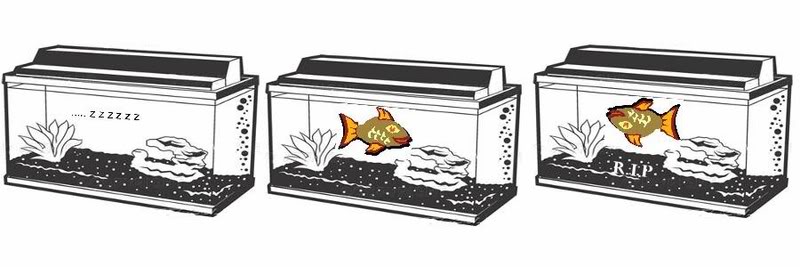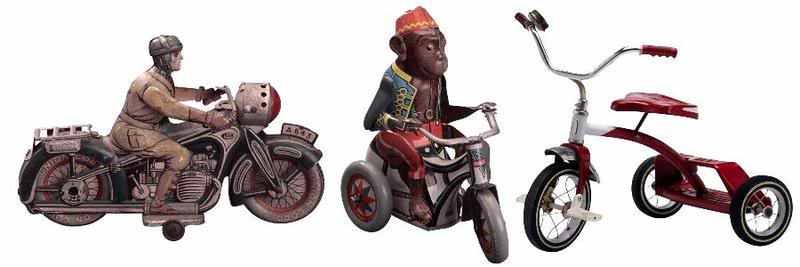RJRofFL
Aquarium Advice Activist
Fishless Cycling For Dummies
(written by a dummy)
(written by a dummy)
New Tank?..................... Can’t Wait?..................... What Happened?

Why Cycle?
I doubt that any of you would consider bringing home that new little cute & cuddly kitten from the pet store, lock him in a closet with a litter box, throw in a can of cat food, close the door and let him live in his own waste. Of course not! Besides, he probably doesn’t even know how to use the can opener. Naturally, you prepare his area in his new home, with a clean dish, clean pillow and a fancy little feather toy. Well, I can tell you that fish do not like fancy little feather toys, but the concept is the same.
What is a Cycle?
Life is full of cycles, bicycles, tricycles, but this one is called a nitrogen cycle. It deals with bacteria; bad bacteria and not so bad bacteria. In simple terms, things live, eat, breathe and die. An end result is ammonia (bad). However, a bacteria, called Nitrosomonas spp., works to convert toxic ammonia to nitrItes. NitrItes, also toxic to fish, are converted by another bacteria, Nitrobacter spp. into Nitrate (not as bad, but bad). So we start with bad and end with not so bad. See, it’s a cycle! I’m sure that made no sense to you, but, you really don’t have to know what it is as much as how to do it. Hint: Those two words Nitrite and Nitrate seem similar but are not. So to remember them we’ll call them NitrItes and NitrAtes. (Or, if you really want to impress your favorite guy/gal you can use NO2 and NO3)
Why Fishless Cycle?
In addition to being a more humane process, since there are no fish in the tank to be harmed, it offers complete and total control over the process, is quite forgiving should mistakes be made, easily corrected, and if done properly, can allow for a slightly larger quantity of fish to be introduced at once.
However, I feel that best way to justify using this method is that Fish have rights. Just as any other animal in our care, whether domesticated or not, at one time was taken from its natural environment, and at that particular point we must assume the responsibility of providing a safe and healthy environment, allowing it to achieve, as it is entitled to, a good quality of life. (Remember the kitty cat?)
What do I Need?
- First and foremost – a good quality liquid test kit – one that tests for ammonia, nitrite and nitrate (that’s all for now) – around $20-$30. Yes, I know it is expensive, but, heck, you already spent more than that on that stupid Castle, Sunken Ship, or Ship’s Wheel you have sitting on the bottom of the empty tank.
- A pen or pencil and a Notebook. You are going to want to record your daily readings with the test kit, and probably refer to them often. You can also use it for photos.
- A bottle of pure ammonia. Since there are no fish, we are going to manually add the ammonia for the other bad boys to go after. It’s important that it be pure ammonia without any surfactants. Test-shake it, if it bubbles put it back!

Patience. Tanks cycle in their own time, you cannot force the process, however, in my experience I have found the fishless method to be faster than the “traditional” method.
Point: Of course the addition of some “already cycled” substrate, filter media, decorations, etc. that you might get from a friend will aid in speeding the cycle,
But, alas, some of us don’t have any friends, so you may skip this.
Point: Contrary to some beliefs, the bacteria we are attempting to introduce will mostly take residence in the substrate, filter and walls of the tank. Very little, if any, lives in the water.
Point: The time tables in this example may not coincide with your particular setup, since obviously I have no idea of the size of your tank, filter, heater, etc. Remember, I’m a dummy. The dosage, too, you will have to calculate to suit your setup. I can’t do that for you, I’m not that much of a dummy.
Weeks 1 – 2
Stand good and sturdy. Make sure it’s level. Decorations & substrate in. Filter & heater in place. Filled with water. Filter & heater turned on. (approx 80-83 degrees). Test Kit ready.
Add ammonia. Start with 2-3 teaspoons. Wait an hour. Test (for ammonia only). What we are aiming for here is to get a test reading of 3-5 ppm (that’s parts per million for the techies here)
After an hour or so, you may have to add more.(for example if you get a zero reading, Doh!) Just remember, we’re looking for 3-5 ppm for a reading.
If you overdose, a little, that’s OK. (Have you ever heard a doctor say that?). Remember, no fish here to hurt. And this is not rocket science. A 6 ppm reading is OK too. Just don’t go crazy bonkers.
Now we wait. (I’ll bet you’ve heard a doctor say that!). Continue to test (for ammonia only) each day. Don’t forget to record your readings in that sexy notebook you bought. Remember in the beginning we mentioned Patience. That is the downfall of many - Patience. Perhaps it might help to read a book while waiting. I can recommend one, it's a short story and in paperback. It's called "The Illusionist" by Stephen Millhauser. OK, moving right along.
Near the end of the 1st week, start testing for NitrItes as well as ammonia. Don’t be alarmed if you get zero. Keep testing. Remember, this takes time.
Somewhere into the 2nd week you should see some reading for NitrItes. During this time you should also see ammonia start decreasing. That’s a good thing.
Weeks 3 - 4
By the 3rd week you should see the NitrIte reading increase and at the same time see the ammonia decrease.
Once the ammonia reaches zero, just add 1 teaspoon of ammomnia each day. Not enough to cause a reading, but just enough to keep the “ammonia eating” bacteria alive and happy. Note: This is a step a lot of people forget or omit and sometimes this omission causes the cycle to stall or stop. Remember to keep feeding these little buggers.
In the meantime, the NitrItes should start climbing and climbing. Somewhere in the 3rd or 4th week they should peak and start dropping down. This is a sign that you’re getting close, and cause for celebration. Go have a beer.
At this point we grab our trusty Test Kit and test for NitrAtes. This part of the process will probably move faster than the previous ones. As with earlier tests, this new NitrAte should start climbing and the older NitrIte should start dropping. And by now, your ammonia readings should always be zero. Onward to infinity! (Buzz Lightyear said that)
Hey, remember that book I recommended for you to read back in week 1 or 2? Well, I have to tell you, she really didn't die. It was all a trick. And then she ran away with the good guy and they lived happily ever after.
What? You didn't finish it? Oops!
Weeks 5 – 6
If it hasn’t already, somewhere in the 5th week the NitrAtes will continue to rise, and the NitrItes should rather quickly lower to zero. In my case the NitrItes dropped to zero within 3-4 days after it spiked.
When your NitrItes are zero and your ammonia is zero, then, (drum roll please) your tank is cycled!
Don’t break out the champagne yet, there’s one more step (and it’s pretty darn important). Do a large water change (60% - 80%) to bring the still present NitrAtes down to a non-toxic level (which is <20). After the water change, do not, I repeat, do not remove or change the filter media, (hey, that’s where a lot of those little good bacteria guys are!). Add your water conditioner and lower the temperature to 76 degrees or whatever is proper for your about to become resident FISH!
As a good measure, and common sense, allow you newly cycled tank to churn away for a few hours, or overnight. Test one more time. (you can never test too much), and as long as you see those zeros there and the NitrAte <20 – you are good to add FISH!
Don’t go bonkers, though. Even though you can certainly add more than one fish, that doesn’t mean you should dump in twenty. Just remember that as you add fish, and only a few at a time, you must give the good bacteria a little time to adjust to the increase in numbers and waste.
I truly hope that I have convinced you to go with the fishless cycling. I can guarantee you that your fish will thank you, too, by letting you watch them live a happy, healthy life for many years, and will occasionally give you a wink! (or maybe a high five!).
Good Luck.
Bob R
Last edited by a moderator:
